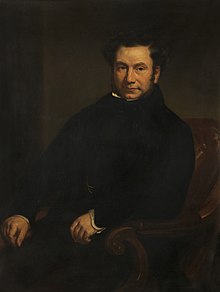B. Hick and Sons
[25][26] Benjamin Hick's wheel design was used on a number of Great Western Railway engines including what may have been the world's first streamlined locomotive; an experimental prototype, nicknamed Grasshoper, driven by Brunel at 100 miles per hour (160 km/h), c.1847.The 10 ft disc wheels from GWR locomotive Ajax were lent to convey the statue of the Duke of Wellington to Hyde Park Corner[27] in London.The forms, dimensions, nature, and strength of material of the naves, discs, and fellies, as well as the mode of uniting the different parts, may be varied, in order to suit the particular purpose for which the wheels are required, and to the wear and tear to which they are liable'.[12] Examples using wood paneling as streamlining are applied to the 16 ft flywheel and rope races of a Hick Hargreaves and Co. 120hp non-condensing Corliss engine, Caroline installed new at Gurteen's textile manufactorary, Chauntry Mills, Haverhill, Suffolk in 1879.[37] Hick's third and youngest son William (1820–1844) served as an apprentice millwright, engineer in the company from 1834 and a 'fitter' from 1837, he was listed as an iron founder in 1843 with his eldest brother John, but died the next year.[56] Leeds Industrial Museum houses a Benjamin Hick and Son beam engine in the Egyptian style c.1845, used for hoisting machinery at the London Road warehouse of the Manchester, Sheffield and Lincolnshire Railway.[69] An early horizontal Corliss type built in 1866, arrived in Australia the following year for Bell's Creek gold mine, Araluan, New South Wales; the engine is now housed at Goulburn Historic Waterworks Museum.[75] Hargreaves and Inglis trip gear was first applied to a large single cylinder 1800 hp Corliss engine at Eagley Mills near Bolton and the company received a Gold Medal for its products at the 1885 International Inventions Exhibition.[76] An 1886 Hick, Hargreaves and Co. inverted, vertical single cylinder Corliss engine with Inglis and Spencer trip gear, used to run Ford Ayrton and Co.'s spinning mill, Bentham until 1966 is preserved under glass at Bolton Town Centre.[77][78] Lüthy was appointed superintendent of hydraulic apparatus in 1870, about August 1883 he went on business to Australia connected with the shipping of frozen meat and to inspect machinery for a large freezing establishment, but died suddenly on 3 July 1884, the day after he returned home.[93] The company's recoil gear for the Vickers 18 pounder quick firing gun was so successful that, by war's end, a significant part of the factory was devoted to its production.[97] Trained at Faraday House Engineering College, from outside the Hargreaves family circle and established conventions of the industrial regions, Madden ensured the business was run economically during the difficult times ahead.Between 1946 and 1947 it supplied vacuum pumps to Vickers Armstrongs for the Barnes Wallis designed Stratosphere Chamber at Brooklands, built to investigate high-speed flight at very high altitudes.Two switchgear panels; the works clock, and a pair of cast iron gateposts with Hick's caduceus logo were preserved by the Northern Mill Engine Society.[122][123][124][26][125][126] In 2001, BOC bought the business from Smiths Group and relocated the offices to Wingates Industrial Estate in Westhoughton, and subsequently to Lynstock Way in Lostock, as part of Edwards.


Hick Hargreaves early locomotive drawings , 1974.


General partnershipEngineeringHeavy industryBenjamin HickBoltonJohn Hargreaves JrJohn HickGeorge Henry CorlissRothwell, Hick and RothwellGeorge Pattensteam locomotivecarrierJohn Hargreavesgear-drivenrail carriagesolicitorbankerturnedspokesPontchartrain RailroadSt. Charles Streetcar LineNew Orleansstationary engineCarrollton Railroad CompanyJefferson Parish, LouisianaironworkingtenderFredericksburg and Potomac RailroadRaleigh and Gaston RailroadNorth CarolinaEdward Bury and CompanyMidland Counties RailwayLondon and Birmingham RailwayNorth Union RailwayManchester and Leeds RailwayGrand Crimean Central RailwayLondon and North Western RailwayTaff Vale RailwayEdinburgh and Glasgow RailwayCheshire, Lancashire and Birkenhead RailwayChester and Birkenhead RailwayEastern Counties RailwayLiverpool and Manchester RailwayNorth Midland RailwayParis and Versailles RailwayBordeaux RailwayBirmingham and Gloucester RailwayNorrisLickey Incline"long boiler" locomotivesNorth Staffordshire RailwaypatentGreat Western Railway enginesstreamlined locomotiveBrunelstatue of the Duke of WellingtonHyde Park Cornerwaggonscoachesflywheelrope racesCorliss engineHaverhill, SuffolkDisc wheelsarmoured carsdrag racingLand speed recordLand speed racingmotor racingmotor scootersmotorcycle speedwaywheelchair racingicetrack cyclingvelomobilestrack cyclingtrack bikestime trialsdrawingsromantic outlookTransport TrustUniversity of SurreyLiverpoolGeorge Forrester & CogovernorEgyptian wingedMechanics' Magazineapprenticemillwrightengineeriron founderSilwood ParkcolumnGreat ExhibitionClaude-Marie FerrierThe Great Exhibitionhorse powerHibbert, Platt and Sons'cottonoscillating engineforginggearingradial drillmandrilsforgesbeam engineEgyptian styleJohn Marshall'sTemple WorksScience MuseumBolton MuseumEgyptianBritish MuseumLeeds Industrial MuseumManchester, Sheffield and Lincolnshire RailwaymarinestationarypaddlefrigatesDom AfonsoThomas Royden & SonsAmazonasRoyal WilliamMediterraneansteamersAlexander Denny and BrothersDumbarton